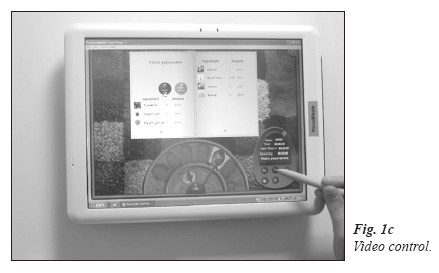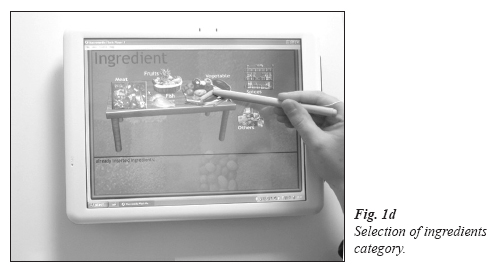Articles
Computing Technologies in the Kitchen:
The Living Cookbook as a Design for Mindful Cooking Experiences
Lucia TerrenghiRésumé
Cet article examine la manière dont les outils informatiques multimédias peuvent venir à l’appui de l’apprentissage de la cuisine à la maison, en considérant la famille comme une communauté de pratiques, et le processus de la cuisine comme une activité que l’on peut partager. Nous présenterons l’exemple d’une telle conception par l’intermédiaire de « l’ustensile de cuisine » Living Cookbook [livre de cuisine vivant]. Celui-ci sert à accéder à des vidéos de sessions de cuisine familiale, afin de permettre la création et le partage d’instructions de cuisine personnalisées et multimédias.Abstract
This article considers how multimedia and embedded computing technologies can support the domestic learning of cooking, thus considering the family as a community of practice and the cooking process as a sharable activity. Such a vision is exemplified with the Living Cookbook computer appliance: This relies on the video capture and retrieval of family members’ cooking sessions, so as to enable the creation and sharing of personalized, multimedia cooking instructions.1 Families grow and evolve as “communities of practice” (Wenger 2002), relying on their members, rituals and artifacts to build, maintain and transfer the community identity through generations. Domestic foodscapes are shaped by such rituals, artifacts and social interactions. The kitchen has traditionally been populated by a diverse range of artifacts supporting families in the preparation of food—cooking tools, appliances and cookbooks, all of which contribute to the representation of the material culture of a generation and of a society. This article considers the implications and potentials of integrating computing technology into the kitchen, and investigates how such integration can affect social behaviours around cooking in such a way as to enhance mindful food-related experiences.
2 The transmission of knowledge regarding family practices within the home occurs in large part through storytelling, performance, observation and regular routines. As David Sutton convincingly demonstrates in his essay elsewhere in this issue, adult family members are role models for younger generations in the enculturation of domestic activities that include among other things, house cleaning, laundry and cooking. When family members live apart from one another—making learning through observation by being part of the daily rituals impossible—other forms of media are often used to communicate instructions. One might telephone home for a recipe or for guidance on a particular aspect of the cooking process. A food expert from outside the family could be contacted for a specific recipe or to confirm the consistency of a soup or a sauce.1 But while some of the communication around cooking—including the exchange of recipes, especially within households or close social networks—is one-to-one in real time, a diversity of media ranging from paper sources to websites to smart-phone applications such as Epicurious2 are continuously expanding ways of acquiring cooking know-how and food connoisseurship. At the same time, these new communication and recipe sharing vehicles establish and reinforce social bonds and the sense of belonging to a larger community of practice. Significantly, above and beyond the informative function and value of these media, the specific properties of each medium have a profound influence on our affective relationship to a recipe and, to a larger extent, food and eating itself. In turn, these new media have implications for the way we pass on cooking and eating behaviours. A hand-written recipe, for example, might carry nuances of nostalgia and heritage by virtue of the personal touch of its lettering and the personalized communication between the writer and the reader. Hence recipes warrant consideration as conduits of information and transmitters of family values. Sharon L. Jansen, for example, analyzes samples written by her mother as “exercises in narration, description, analysis, even argument … they raise questions about texts and context, about text and subtext, about textual authority and textual subversion” (2005: 55-56).
3 When, where and what we eat in a community is largely a reflection of the values we were exposed to in our families, and by the way food was prepared and consumed at home (Avakian 2005; Bell and Valentine 1997; Short 2006; see also Richman Kenneally and LeBel in this volume). The preparation of food for family has a dimension that often goes beyond the basic function of nutrition: to cook for another is to symbolically perform an act of care. Consciously or not, families and communities have been known to anchor key elements of their collective identity on the archiving and perpetuation of their recipes as a form of tradition. Responding to such notions, Janet Theophano interprets cookbooks written by homemakers as expressions of themselves, as autobiography in that they providean accounting of days and tasks, the accumulated wisdom and knowledge that a woman garnered over the years of her life as wife, mother, daughter, kin, friend, healer, reader, writer, and as an individual. On the pages of these texts she celebrated her successes, documented her own and her children’s development, and dreamed about and longed for new and different experiences.” (2003: 154)Anne Bower (1997) sees community cookbooks3 as repositories of shared memory not only because they contain the recipes of members of the social group that generated the collection, but also because they document the history of that community, including the history of how the recipe collection itself was assembled.
4 Despite the fact that home cooking is a time-honoured practice, without question the home preparation and consumption of the family meal has in recent years been subjected to a variety of interventions—contributing to an overall reduction in family engagement in the domestic cooking process. Convenience food producers playing on the overworked consumer’s need for efficiency have generated much of this change. As Ritzer (among others) has argued, such incentives have generated an “I don’t have time to cook” (2004: 47) attitude that has had a profound effect on family rituals and behaviours with regard to food and eating. Saving time has been the rationale, as well, for an influx of domestic kitchen technology, such as food processors and microwaves, inevitably reducing the process of cooking to a functional task with an attendant loss of the symbolic, social and cultural meanings associated with food preparation. From this perspective, technology can be argued to serve as a deterrent, at least to some extent, in the transmission of time-honoured practices and rituals associated with food.
5 On the other hand, as Moisio et al. observe, homemade food continues to be instrumental in the construction of family identity and “provides a metonym for a model of household activities that marks intergenerational care-giving, altruism and love as model characteristics” (2004: 379). This being the case, and given the demonstrated centrality of recipes and cookbooks as markers of cultural affiliation and commemoration, as mentioned above, is it possible to reinforce mindful food experiences by recasting the role of technology and media-based artifacts, specifically as conduits for social engagement? As a means of exploring this question, this essay focuses on the design and evaluation of the Living Cookbook, a computer appliance developed at the Ludwig Maximilian University of Munich in 2006 specifically for sharing recipes in the form of multimedia cooking experiences. This author, along with Otmar Hilliges and Andreas Butz developed the appliance.
Technology in the Kitchen
6 From a design perspective, I argue that the kitchen is a socio-technical environment that is capable of accommodating technologies that can augment existing cooking activities. Without doubt, the nature of the kitchen as a socio-technical environment has long been demonstrated by the use of ever-evolving material culture such as stoves, refrigerators and microwaves. In the case of the Living Cookbook, however, the innovation is in the employment of digital technology and, more specifically, the conceptualization of the kitchen as a site to be addressed through the field of Human-Computer Interaction (HCI). HCI is defined as “a field of research and development, methodology, theory, and practice, with the objective of designing, constructing, and evaluating computer-based interactive systems … so that people can use them efficiently, effectively, safely, and with satisfaction” (Hartson 1998: 103).
7 Arising from the association between computer and behavioural sciences, HCI was progressively embraced by other disciplines—sociology, anthropology and design, among them. This evolution was motivated, in particular, by (the late) Mark Weiser’s vision of “ubiquitous computing” or UbiComp as it is generally called. A visionary in the field of information technology, Weiser led the team of researchers at the Xerox Palo Alto Research Centre in California for much of his ten-year tenure with Xerox. Weiser foresaw the day when computers would be integrated seamlessly into our world. He wrote: “We are … trying to conceive a new way of thinking about computers, one that takes into account the human world and allows the computers themselves to vanish into the background” (94). While ubiquitous computing is not yet part our lives as imagined by the PARC researchers (Rogers 2006), it is slowly becoming part of our 21st-century world. Indeed, the integration of computing capabilities into physical artifacts (walls and furniture, for example) was key in the design field’s interest in HCI. Automation was considered one of the most promising features of ubiquitous computing, leading to the design of “smart objects” and “smart environments,” which—because of networked sensors detecting movement, temperature, sound, and the like—could adapt to the users’ desire to get the most efficiency from the expenditure of effort and the use of time. As digital technologies moved beyond the office to other environments, newer technologies pointed to potentially fruitful ways to engage users in novel and interactive experiences whose value, albeit, does not necessarily lie in time-saving or automation of activities (Gaver et al. 2003; Rogers 2006; Shneiderman 2003; Terrenghi 2006).
8 In keeping with the view that not all projects and processes are focused on automating activities or saving time, the aim of the Living Cookbook project was to tease out aspects of information technologies that seek and encourage self-expression and creativity on the part of users and, in turn, to design technology to support and motivate the spending of time for the sake and enjoyment of creating and communicating. In this sense, the Living Cookbook differs to a significant extent from related projects, products and approaches that strive for task efficiency. In Western kitchens, most electric appliances have consistently been developed and marketed around a promise of decreasing user effort, maximizing the efficiency of certain tasks, or even achieving their complete automation.4
9 More recently, however, some manufacturers of domestic appliances have addressed the potential of digital displays and internet technology to augment the kitchen environment, bringing information and entertainment into that space. The GR-D267DTU Internet Refrigerator5 by LG, for example, contains a server that controls communication with other connected appliances. On the display, different functions are embedded, making it possible to watch TV, listen to music or surf the internet; a built-in microphone and a camera enable multimedia communication. In order to investigate future scenarios of technology-enhanced housing, several research institutes, companies and universities have set up so-called smart houses or smart homes in which potential users can experience such interactive environments. These prototypical houses are also known as “living labs.”6 Participants (either the researchers or recruited test users) are invited to live in these living labs for periods ranging from one to ten days while their behaviours and interactions are recorded and analyzed. While certain advantages are to be gained in observing what happens in these spaces, limitations to the methodology must also be recognized, including the reliance on artificial, ad-hoc designed places as opposed to actual, more natural environments, and the possible modification of participant behaviour given the fact of being observed.
10 Other attempts at augmenting the kitchen environment as a whole have also been undertaken. At MIT, for example, a smart (digitally-equipped) kitchen called La Cantina features displays embedded within the kitchen space that make possible a variety of augmentations, mostly dealing with artificial intelligence (Bonanni et al. 2005). Another example is the CounterActive project (Ju et al. 2001), an interactive cookbook incorporating still and video images as well as audio, to be projected onto the kitchen counter so that the cook touches the countertop to navigate through or focus on specific details of a recipe.
11 With the Living Cookbook, the idea is to stimulate the explicit and conscious engagement of users with technology. This provides a means to capture the user’s own experience, and to play back the experiences of others, facilitating exchange and communication. In this project, technology is not concealed within the infrastructure of the home (as Weiser envisioned), but is instead in the foreground, providing an opportunity for entertainment and opportunities to generate deliberate acts of family communication. Similar to the CounterActive project mentioned above, the Living Cookbook moves beyond the traditional cookbook by delivering and displaying multimedia content. At the same time, the focus of the Living Cookbook is on the augmentation of social and family relationships and real life experiences; the intent is not to create a multimedia environment for its own sake. In other words, the Living Cookbook recognizes the social value of cooking as well as the many rituals and symbolic aspects involved therein. Moreover, it anticipates and accommodates the variety of motivations underlying the practice of cooking—meal preparation as a means of social contact with others involved in the cooking process; cooking for friends or loved ones as a gesture of care; an opportunity to impress friends and relatives or the mere desire to exchange recipes. In this sense, the Living Cookbook moves away from the basic automation of domestic tasks and computing’s primary focus on productivity. Instead, it highlights and supports the potential inherent in the act of cooking to communicate and strengthen the social ties that bind a community of practice. From this perspective, the Living Cookbook supports a mindful approach to eating in the domestic foodscape, by enabling an enriching array of interactions in the preparation, consumption and reflection of food. Finally, the Living Cookbook provides a lens through which to explore other possibilities wherein technology can encourage fulfilling social engagement in the home as well as a greater sense of accomplishment, self-expression and family exchange.
The Design and Function of the Living Cookbook
12 The main motivation in the design of the Living Cookbook appliance was to make people’s cooking experiences recordable and shareable across time and space, in a format that could foster a sense of collaborative or community participation, and at the same time to serve as the repository of a family’s culinary heritage.
13 Ease of use was a priority. The appliance consists of an application running on a tablet PC with a touch-sensitive screen; users can interact with either a pen or a finger. It also includes a camera and a projector. A digital cookbook is displayed on the tablet (Fig.1), and users have the option to either create a new recipe and add it to their personal virtual book, or consult the book and learn about someone else’s recipes. Cooking sessions can be captured on video and played back for later use by the same author or another user. When recording, the cook can indicate phases of activity and inactivity in the user interface. When playing back, the device projects the recorded video of activities and pauses during times of inactivity; the cook can also speed up or slow down the playback by advancing to the next section or pausing to catch up. The Living Cookbook thus provides a user interface that can be customized to the user’s cooking needs, abilities and speed. It also gives users the possibility of revisiting one’s personal digital recipes and recorded sessions as well as recipes authored by others, enhancing a sense of ownership and of shared memory. Annotation of existing recipes is also possible through the interface.
14 Simple icons were designed to be familiar to an extended audience who do not necessarily use desktop PCs on a regular basis. The dial (Fig. 1a) displays the cookbook selection. Portions can be specified by dragging plates onto a table (Fig. 1b); and video control is operated through an egg-shaped graphic element resembling a cooking timer (Fig. 1c). On the dial, users can choose from among a set of cooks/“buddies,” and from among the various courses of a meal. This combined selection triggers the appearance of the cover of the book, displaying the picture of the selected cook/home inhabitant and the desired course (Fig. 1a). Users tap on the cover to open the book, resulting in a list of recipes being displayed. By virtue of these controls, the Living Cookbook device fulfills the intention to minimize text input. Wherever possible, the interface affords direct manipulation, such as tapping and dragging. Instead of entering the text for ingredients’ names and quantities, for example, cooks select them from categories represented by images (Fig. 1d).
Fig. 1a Selection of cook and course on the dial.
Display large image of Figure 1
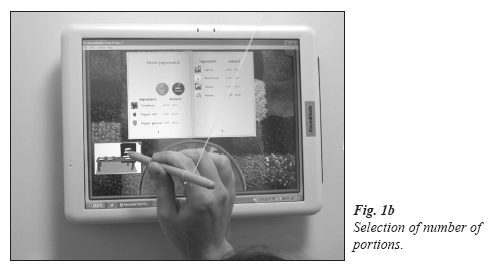
Display large image of Figure
2
Testing the Living Cookbook prototype
15 The testing phase of the Living Cookbook revealed the strengths of the project and also highlighted strategies for its improvement. Three distinct testing stages were undertaken, each a refinement of the previous trial.
16 The first test of the Living Cookbook prototype shed light on the usability and desirable features of the appliance, but underscored the challenges in trying to assess the project (specifically its efficacy in motivating and supporting family learning and communication) within a laboratory setting rather than in the home environment. This first interaction took place in a test kitchen of the Media Informatics Lab of Ludwig-Maximilan University (Munich) (Fig. 2a), where the apparatus was mounted on a cupboard above the stove. A projector connected to the server, was used for displaying the video on a wall beside the cupboard, as illustrated in the schema of Fig. 2b. Two cameras were connected to the server to record the cooking session; it provided two views, one focusing on the counter and one on the cook. A speech recognition component was also implemented to recognize certain verbal commands, such as “record,” “play,” “pause” and “stop.” Each participant was introduced to the appliance and instructed either to create and document a recipe task, or to learn one already contained in the cookbook. While interacting with the interface, they were invited to use kitchen utensils and reproduce actual cooking tasks, so as to simulate as much as possible a complete cooking session in a real domestic kitchen.
17 During the test, participants were asked to speak aloud; after the experiment they completed a questionnaire inquiring about their general satisfaction with the Living Cookbook and with their personal experience of using the appliance.
18 During this first trial, participants noted that the appliance could provide better feedback than traditional cookbooks. In particular, male participants mentioned the usefulness of having visual feedback or instructions on specific and more elaborate tasks that were unfamiliar to them. In contrast, female participants noted the advantage of the application more as emotional support than as cooking instructional support because they could see their relatives and friends. Younger participants, especially those having recently moved out of the family home, reported that they often called their mothers to ask for recipes and exact instructions for food preparation. Those participants saw a benefit in both the visual feedback and personalized content of the Living Cookbook. On the other hand, participants were generally at a loss to imagine whether and how they would use the appliance in their own kitchens and with their own family members.
Fig. 2a (top) A participant is interacting with the Living Cookbook in the kitchen of the lab.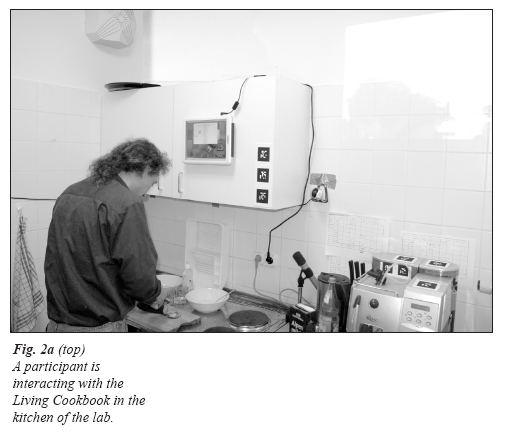
Display large image of Figure
5
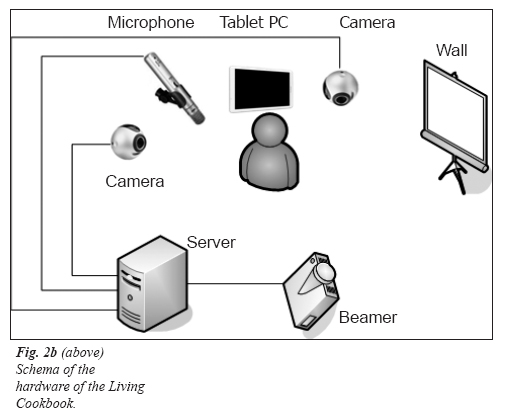
Display large image of Figure 6
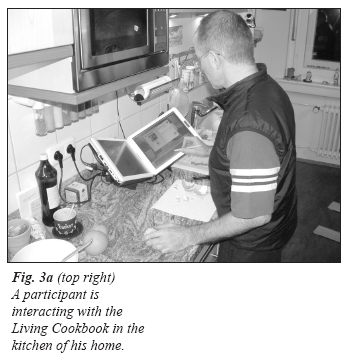
Display large image of Figure 7
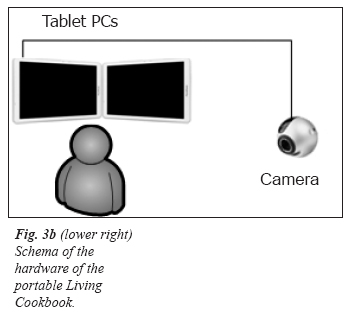
Display large image of Figure 8
19 The next phase of prototype testing took place in the domestic kitchens of two families, where the set-up consisted of two tablet PCs side by side such that their physical appearance suggested the shape of an open book (Fig. 3a). The right tablet PC displayed the user interface, while the left one displayed the video components (record and playback). The device was installed in each kitchen for a week and the families were asked to report on their experience. One household consisted of a couple with a young baby (husband 30 years old, wife 31, child 15 months); the other, a couple with three children (husband 54 years old, wife 39, daughters 15 and 5 and 8-year old son).
20 Interviews with both families revealed the appeal of the Living Cookbook as a family archive. The first family’s favourite feature was the opportunity to create and watch videos of family members while they were cooking; the resulting videos were pronounced fun and intimate, as opposed to the activities of professional cooks on television. The second family reported that they did not enjoy using the appliance but, instead, perceived it as necessitating additional domestic effort (“one more task to take care of”). The 15-year old daughter, on the other hand, enjoyed the experience and even invited a girlfriend to help her cook with the aid of her parents’ video. She said that she had fun and stated that she would be more motivated to cook because of the entertainment value. This response signalled the potential of the Living Cookbook as a cross-generational cooking tool. This fact motivated a third study of the prototype, this time with teenagers in a focus group format.
21 The teen focus group involved eight participants between the ages of 14 and 16 years, who attended a “Household and Nutrition” course in a German secondary school. During the focus group, participants were introduced to the Living Cookbook and asked to cook a simple recipe created for them, thus offering them hands-on experience (Fig. 4). The discussion then focused on their impressions, ideas and criticism of the appliance.
22 These participants found the appliance playful and entertaining. They could envision an increase in their motivation to cook at home because of the fun factor of watching the videos of parents, siblings and grandparents managing mundane activities, in what they perceived as a kind of “real television” experience. Participants also said they would trust the recipes of the Living Cookbook (more so than those of televised cooking shows) because they were likely to be preparing dishes they had already tasted at home, and because the recipes seemed more doable than those shown by professional chefs on television. In addition, some of the participants said that they would feel more relaxed and less constrained cooking with the Living Cookbook than with their parents. It was also noted that by visually documenting one’s own recipes for others, learning-by-doing was indirectly supported because the act of teaching a recipe inherently implies putting it into practice. Finally, despite the fact that the value of video support was appreciated in general, participants also provided useful criticism: the need to provide “rewind” functionality for the audio and video instructions, for instance, so that important steps could be re-accessed as necessary.
Implications of the Living Cookbook
23 The results of this preliminary investigation of the Living Cookbook in laboratory as well as field settings offer a chance to reflect on the role of technology-based material culture as a means to support the transmission of family culinary traditions and mindful eating practices in a domestic environment.
24 First, the fun, social engagement and entertainment value of the Living Cookbook points to potentially fruitful applications of technology to support domestic practices.7 That is, technology could conceivably support mindful eating and cooking practices, especially when designed with a comprehensive understanding of the context of application and the target users. In the results reported here, for instance, the Living Cookbook was perceived as an engaging device that could make cooking more fun and inviting only when the appliance was tested in a real domestic context and when specific target users (i.e., the participants of the focus group) were involved. This points to the need to design new computing technologies for domestic foodscapes with an appreciation for the users’ subjective experience as well as for the physical and social contexts in which this appliance is to be used—and not to push technology for its own sake. The possibility for the users to move around within the architecture and among the material culture of the domestic foodscape—and directly manipulate both the objects and the information therein—needs to be supported by interfaces that are properly scaled to users’ metrics and their specific location within that built environment. Other issues that centre on the relationship between the body of the user and the interface are particularly important when thinking of younger or disabled users: the height of the user and their visual angle, for example, and environmental factors such as sound, smoke, heat and dirt. In developing these new applications, there is an obvious need for collaboration among experts who study material culture in the built environment across various disciplines including design, architecture and anthropology.
Fig. 4a The pupils discussing the learning of cooking in the focus group.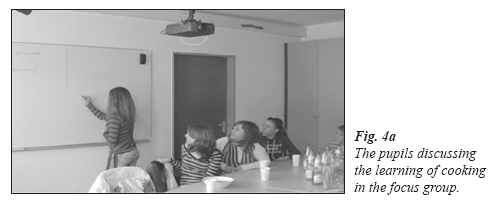
Display large image of Figure 9

Display large image of Figure 10
25 Second, from a design research perspective, the current results also point to the eventual benefits of using tools such as the Living Cookbook to support and build on existing cooking activities. It is exciting to imagine the repository of family recipes and cooking practices that could be collected and analyzed via the Living Cookbook, and to consider how such records could inspire even more novel approaches to support mindful eating. Like the Living Cookbook, other such devises and mechanisms could engender technologically-supported experiences that encourage users to move beyond the primary criteria of usability and functionality of the interface per se, and devote sustained attention to human values and practices—specifically in the kitchen where computing technologies have known only limited use to date.
26 Finally, the findings of the Living Cookbook experiment suggest that concerns about the potentially disruptive nature of new technologies on an established social ecosystem (concerns that have arisen from research on the environment of the office, for example) deserve reconsideration. The feedback given by different target users suggests that attention must be paid to the roles played by different members of a family. There are exciting implications derived from the reports of the younger users who identified a fun factor derived from watching their parents; such a consequence might well encourage them to use the appliance and perhaps, ultimately, to cook more frequently. Similarly, one can speculate that elderly individuals or people living alone might enjoy watching their relatives in their domestic environments, thus providing a vitalizing sense of presence and of memory. Some parents, on the other hand, expressed their concern that the use of such an appliance would be too time-consuming, despite the fact that they recognized the value of the family archive. This diversity of opinion is consistent with generational differences about embracing new technologies.8 For adults, then, the motivation for using such a tool is their commitment to other family members, and to the next generation in particular. A lesson to be learned by designers is the need to account for the diversity of roles played by the home’s inhabitants.
Conclusion
27 The research undertaken in the development and implementation of the Living Cookbook underscores its potential to capture the emotional quality of content created by family members or intimate friends. Instead of simply exchanging written instructions, users can capture the whole cooking experience with annotated audio and video and make it available to family and friends (or researchers!). Other benefits of the Living Cookbook include the fact that its contents can be consulted on demand and, unlike television shows, can be accessed whenever cooking takes place, and wherever an apparatus is available to run the application. The Living Cookbook is in many ways comparable to a family photo album, composed of recorded and shareable family “kitchen stories” (Terrenghi, Hilliges and Butz 2006). In that capacity, it can preserve cultural and social roots and stimulate cross-cultural and cross-generational fertilization. The Living Cookbook thus augments the traditional cookbook by providing an opportunity to pass on family practices and values. It also promotes hands-on, contextualized learning, in addition to teaching family cooking traditions.
28 The outcomes of the project also encourage designers to further investigate the potential of computing technologies to provide novel forms of entertainment as well as to capture, archive and retrieve favoured domestic experiences—activities that can strengthen social ties and promote the transmission of important life-building knowledge in the home.
29 If we think there is a value in promoting hands-on activities such as cooking, and the communication related to cooking, designers and analysts of domestic technology and material culture need to learn about those instances wherein technology is considered supportive rather than disruptive of the social dynamic of the home. We need to recognize those cases in which technology can be staged in the foreground to stimulate engagement and facilitate quality time spent as a household or family unit. If technology is designed to support users’ desire to share and communicate, novel forms of collaboration can also emerge beyond the borders of the household. Remote kitchens and families, for example, could be connected; emerging scenarios of mobile blogging could expand users’ authoring capabilities in time and space, allowing, perhaps for a travelling family member to help the children at home cook and enjoy a proper meal. Cooking is an act of love, sharing and communication that can be supported by new forms of technology. Such technologies can, in turn, support and enhance the diversity of our cultures and richness of our daily lives.
References
Avakian, Arlene Voski, ed. 2005. Through the Kitchen Window: Women Explore the Intimate Meaning of Food and Cooking. Oxford: Berg Publishers.
Bell, David and Gill Valentine. 1997. Consuming Geographies: We Are Where We Eat. London: Routledge.
Bell, Genevieve and Joseph Kaye. 2002. Designing Technology for Domestic Spaces: A Kitchen Manifesto. Gastronomica 2 (Spring): 46-62.
Bonanni, Leonardo, Chia-Hsun Lee and Ted Selker. 2005. Cooking With Elements: Intuitive Immersive Interfaces for Augmented Reality Environments. In Lecture Notes in Computer Science 3585, eds. M. F. Costabile and F. Paternò, 1022-25. New York, Berlin and Heidelberg: Springer.
Bower, Anne. 1997. Recipes for Reading: Community Cookbooks, Stories, Histories. Boston: University of Massachusetts Press.
Buijzen, Moniek, Joris Schuurman and Elise Bomhof. 2008. Associations Between Children’s Television Advertising Exposure and Their Food Consumption Patterns: A Household Diary-survey Study. Appetite 50 (2 and 3): 231-39.
Fiates, Giovanna Medeiros Rataichesck, Renata D.M.C. Amboni and Evanilda Teixeira. 2008. Television Use and Food Choices of Children: Qualitative Approach. Appetite 50 (1): 12-18.
Gabaccia, Donna R. 2000. We Are What We Eat: Ethnic Food and the Making of Americans. Cambridge, MA: Harvard University Press.
Gaver, W. William and Jacob Beaverand, Steve Benford. 2003. Ambiguity as a Resource for Design. In CHI ’03: Proceedings of the SIGCHI Conference on Human Factors in Computing Systems: 233-40. New York: ACM Press.
Gold, Richard. 2007. The Plenitude: Creativity, Innovation, and Making Stuff. Cambridge: MIT Press.
Hartson, H. Rex. 1998. Human-computer Interaction: Interdisciplinary Roots and Trends. Journal of Systems and Software 43 (2): 103-18.
Jansen, Sharon L. 2005. “Family Liked 1956”: My Mother’s Recipes. In Through the Kitchen Window: Women Explore the Intimate Meaning of Food and Cooking, ed. Arlene Voski Avakian, 55-64. Oxford: Berg.
Ju, Wendy, Rebecca Hurwitz, Tilke Judd and Bonny Lee. 2001. CounterActive: an Interactive Cookbook for the Kitchen Counter. In CHI ‘01 Extended Abstracts on Human Factors in Computing Systems: 269-70. New York: ACM Press.
Kirk, David Abigail Sellen, Richard Harper and Ken Wood. 2007. Understanding Videowork. In CHI ’07: Proceedings of the SIGCHI Conference on Human Factors in Computing Systems: 61-70. New York: ACM Press.
Moisio, Risto, Eric J. Arnould and Linda L. Price. 2004. Between Mothers and Markets: Constructing Family Identity Through Homemade Food. Journal of Consumer Culture 4 (3): 361-84.
Ritzer, George. 2004. The McDonaldization of Society 5. Thousand Oaks, CA: Pine Forge Press.
Rogers, Yvonne. 2006. Moving on from Weiser’s Vision of Calm Computing: Engaging Ubicomp Experiences. In Lecture Notes in Computer Science, Volume 4206: 404-21. Berlin/ Heidelberg: Springer.
Shneiderman, Ben. 2003. Leonardo’s Laptop: Human Needs and the New Computing Technologies. Cambridge: MIT Press.
Short, Frances. 2006. Kitchen Secrets. Oxford: Berg.
Terrenghi, Lucia. 2006. Shaping Intelligent Environments: The Sign of Design. In Proceedings of International Symposium on Intelligent Environments, 137-43. Cambridge, U.K.: Microsoft Research.
Terrenghi, Lucia, Otmar Hilliges and Andreas Butz. 2006. Kitchen Stories: Sharing Recipes with the Living Cookbook. Personal Ubiquitous Computing 11 (5): 409-14.
Theophano, Janet. 2003. Eat My Words: Reading Women’s Lives Through the Cookbooks They Wrote. New York: Pal-grave Macmillan.
Weiser, Mark. 1991. The Computer for the 21st Century. Scientific American 265 (3): 66-75.
Wenger, E. 1998. Communities of Practice: Learning, Meaning, and Identity. Cambridge: Cambridge University Press.
Notes
